Comprehensive Report on Entrepreneurship and Small Business Mgmt
VerifiedAdded on 2021/01/02
|13
|3689
|178
Report
AI Summary
This report provides a detailed analysis of entrepreneurship and small business management, focusing on different types of entrepreneurial ventures, their scope, and topology. It examines the impact of micro and small businesses on the economy with statistical data, highlighting their importance in the growth of the social economy. The report also explores the characteristics, traits, and skills of successful entrepreneurs, linking entrepreneurial characteristics to personal background and experience, using the case studies of Elizabeth Gooch (EG Solutions Plc) and Tom Mercer (Moma Foods) in the UK. Furthermore, it differentiates between small, medium, and large entrepreneurial ventures, and discusses their presence in the public and corporate sectors, along with their respective advantages and disadvantages. This student assignment available on Desklib offers insights for students.

Entrepreneurship and Small
Business Management
Business Management
Paraphrase This Document
Need a fresh take? Get an instant paraphrase of this document with our AI Paraphraser
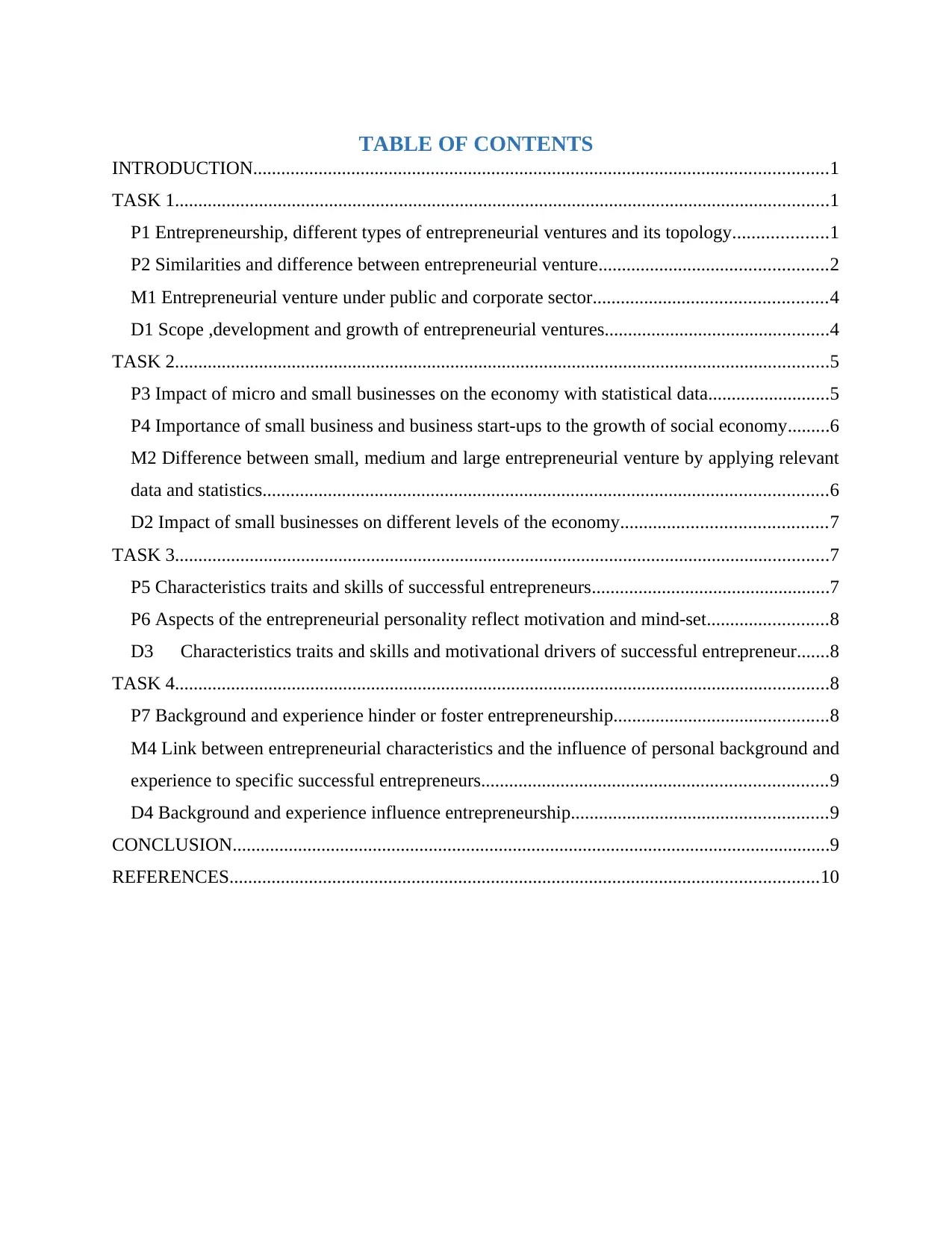
TABLE OF CONTENTS
INTRODUCTION...........................................................................................................................1
TASK 1............................................................................................................................................1
P1 Entrepreneurship, different types of entrepreneurial ventures and its topology....................1
P2 Similarities and difference between entrepreneurial venture.................................................2
M1 Entrepreneurial venture under public and corporate sector..................................................4
D1 Scope ,development and growth of entrepreneurial ventures................................................4
TASK 2............................................................................................................................................5
P3 Impact of micro and small businesses on the economy with statistical data..........................5
P4 Importance of small business and business start-ups to the growth of social economy.........6
M2 Difference between small, medium and large entrepreneurial venture by applying relevant
data and statistics.........................................................................................................................6
D2 Impact of small businesses on different levels of the economy............................................7
TASK 3............................................................................................................................................7
P5 Characteristics traits and skills of successful entrepreneurs...................................................7
P6 Aspects of the entrepreneurial personality reflect motivation and mind-set..........................8
D3 Characteristics traits and skills and motivational drivers of successful entrepreneur.......8
TASK 4............................................................................................................................................8
P7 Background and experience hinder or foster entrepreneurship..............................................8
M4 Link between entrepreneurial characteristics and the influence of personal background and
experience to specific successful entrepreneurs..........................................................................9
D4 Background and experience influence entrepreneurship.......................................................9
CONCLUSION................................................................................................................................9
REFERENCES..............................................................................................................................10
INTRODUCTION...........................................................................................................................1
TASK 1............................................................................................................................................1
P1 Entrepreneurship, different types of entrepreneurial ventures and its topology....................1
P2 Similarities and difference between entrepreneurial venture.................................................2
M1 Entrepreneurial venture under public and corporate sector..................................................4
D1 Scope ,development and growth of entrepreneurial ventures................................................4
TASK 2............................................................................................................................................5
P3 Impact of micro and small businesses on the economy with statistical data..........................5
P4 Importance of small business and business start-ups to the growth of social economy.........6
M2 Difference between small, medium and large entrepreneurial venture by applying relevant
data and statistics.........................................................................................................................6
D2 Impact of small businesses on different levels of the economy............................................7
TASK 3............................................................................................................................................7
P5 Characteristics traits and skills of successful entrepreneurs...................................................7
P6 Aspects of the entrepreneurial personality reflect motivation and mind-set..........................8
D3 Characteristics traits and skills and motivational drivers of successful entrepreneur.......8
TASK 4............................................................................................................................................8
P7 Background and experience hinder or foster entrepreneurship..............................................8
M4 Link between entrepreneurial characteristics and the influence of personal background and
experience to specific successful entrepreneurs..........................................................................9
D4 Background and experience influence entrepreneurship.......................................................9
CONCLUSION................................................................................................................................9
REFERENCES..............................................................................................................................10
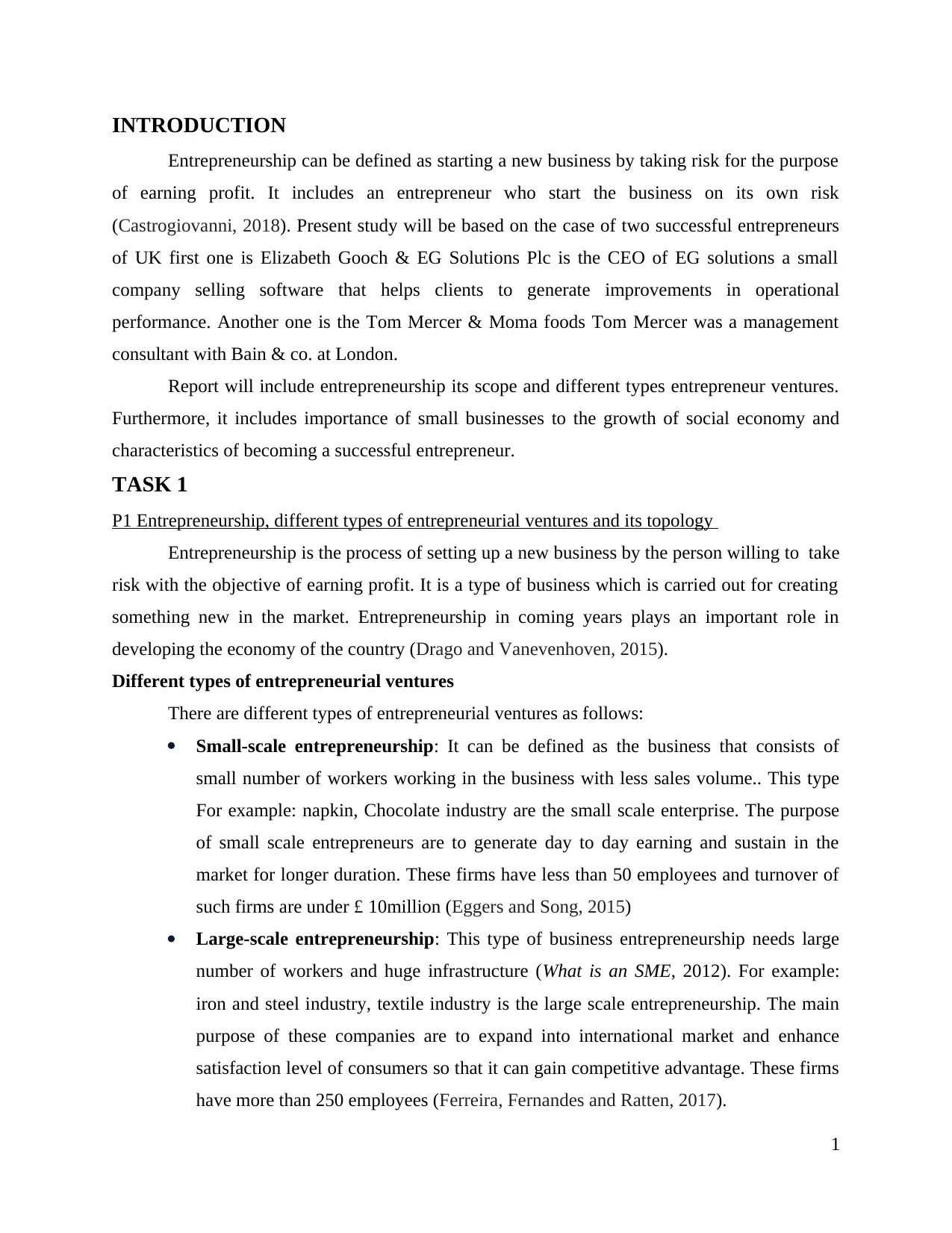
INTRODUCTION
Entrepreneurship can be defined as starting a new business by taking risk for the purpose
of earning profit. It includes an entrepreneur who start the business on its own risk
(Castrogiovanni, 2018). Present study will be based on the case of two successful entrepreneurs
of UK first one is Elizabeth Gooch & EG Solutions Plc is the CEO of EG solutions a small
company selling software that helps clients to generate improvements in operational
performance. Another one is the Tom Mercer & Moma foods Tom Mercer was a management
consultant with Bain & co. at London.
Report will include entrepreneurship its scope and different types entrepreneur ventures.
Furthermore, it includes importance of small businesses to the growth of social economy and
characteristics of becoming a successful entrepreneur.
TASK 1
P1 Entrepreneurship, different types of entrepreneurial ventures and its topology
Entrepreneurship is the process of setting up a new business by the person willing to take
risk with the objective of earning profit. It is a type of business which is carried out for creating
something new in the market. Entrepreneurship in coming years plays an important role in
developing the economy of the country (Drago and Vanevenhoven, 2015).
Different types of entrepreneurial ventures
There are different types of entrepreneurial ventures as follows:
Small-scale entrepreneurship: It can be defined as the business that consists of
small number of workers working in the business with less sales volume.. This type
For example: napkin, Chocolate industry are the small scale enterprise. The purpose
of small scale entrepreneurs are to generate day to day earning and sustain in the
market for longer duration. These firms have less than 50 employees and turnover of
such firms are under £ 10million (Eggers and Song, 2015)
Large-scale entrepreneurship: This type of business entrepreneurship needs large
number of workers and huge infrastructure (What is an SME, 2012). For example:
iron and steel industry, textile industry is the large scale entrepreneurship. The main
purpose of these companies are to expand into international market and enhance
satisfaction level of consumers so that it can gain competitive advantage. These firms
have more than 250 employees (Ferreira, Fernandes and Ratten, 2017).
1
Entrepreneurship can be defined as starting a new business by taking risk for the purpose
of earning profit. It includes an entrepreneur who start the business on its own risk
(Castrogiovanni, 2018). Present study will be based on the case of two successful entrepreneurs
of UK first one is Elizabeth Gooch & EG Solutions Plc is the CEO of EG solutions a small
company selling software that helps clients to generate improvements in operational
performance. Another one is the Tom Mercer & Moma foods Tom Mercer was a management
consultant with Bain & co. at London.
Report will include entrepreneurship its scope and different types entrepreneur ventures.
Furthermore, it includes importance of small businesses to the growth of social economy and
characteristics of becoming a successful entrepreneur.
TASK 1
P1 Entrepreneurship, different types of entrepreneurial ventures and its topology
Entrepreneurship is the process of setting up a new business by the person willing to take
risk with the objective of earning profit. It is a type of business which is carried out for creating
something new in the market. Entrepreneurship in coming years plays an important role in
developing the economy of the country (Drago and Vanevenhoven, 2015).
Different types of entrepreneurial ventures
There are different types of entrepreneurial ventures as follows:
Small-scale entrepreneurship: It can be defined as the business that consists of
small number of workers working in the business with less sales volume.. This type
For example: napkin, Chocolate industry are the small scale enterprise. The purpose
of small scale entrepreneurs are to generate day to day earning and sustain in the
market for longer duration. These firms have less than 50 employees and turnover of
such firms are under £ 10million (Eggers and Song, 2015)
Large-scale entrepreneurship: This type of business entrepreneurship needs large
number of workers and huge infrastructure (What is an SME, 2012). For example:
iron and steel industry, textile industry is the large scale entrepreneurship. The main
purpose of these companies are to expand into international market and enhance
satisfaction level of consumers so that it can gain competitive advantage. These firms
have more than 250 employees (Ferreira, Fernandes and Ratten, 2017).
1
⊘ This is a preview!⊘
Do you want full access?
Subscribe today to unlock all pages.

Trusted by 1+ million students worldwide
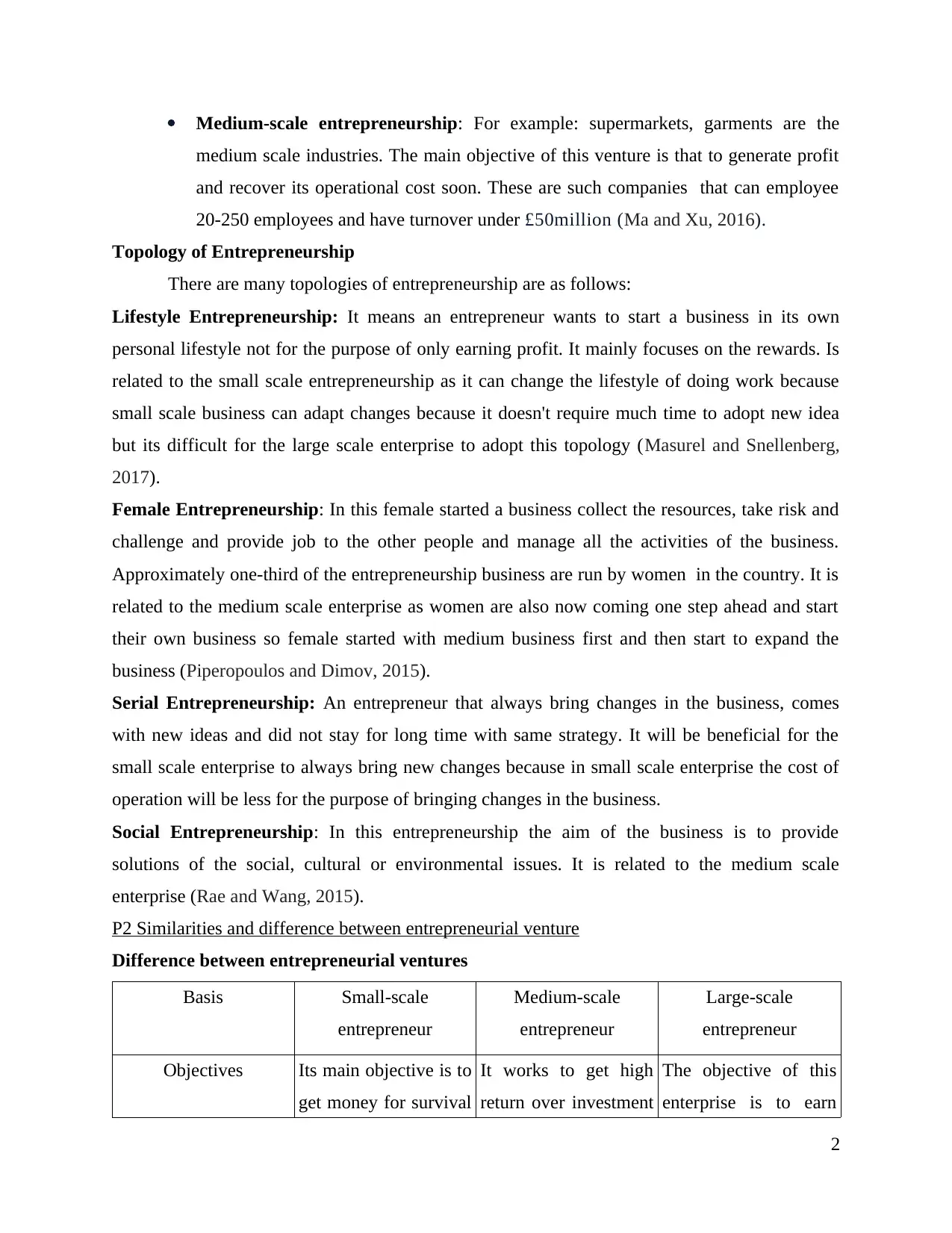
Medium-scale entrepreneurship: For example: supermarkets, garments are the
medium scale industries. The main objective of this venture is that to generate profit
and recover its operational cost soon. These are such companies that can employee
20-250 employees and have turnover under £50million (Ma and Xu, 2016).
Topology of Entrepreneurship
There are many topologies of entrepreneurship are as follows:
Lifestyle Entrepreneurship: It means an entrepreneur wants to start a business in its own
personal lifestyle not for the purpose of only earning profit. It mainly focuses on the rewards. Is
related to the small scale entrepreneurship as it can change the lifestyle of doing work because
small scale business can adapt changes because it doesn't require much time to adopt new idea
but its difficult for the large scale enterprise to adopt this topology (Masurel and Snellenberg,
2017).
Female Entrepreneurship: In this female started a business collect the resources, take risk and
challenge and provide job to the other people and manage all the activities of the business.
Approximately one-third of the entrepreneurship business are run by women in the country. It is
related to the medium scale enterprise as women are also now coming one step ahead and start
their own business so female started with medium business first and then start to expand the
business (Piperopoulos and Dimov, 2015).
Serial Entrepreneurship: An entrepreneur that always bring changes in the business, comes
with new ideas and did not stay for long time with same strategy. It will be beneficial for the
small scale enterprise to always bring new changes because in small scale enterprise the cost of
operation will be less for the purpose of bringing changes in the business.
Social Entrepreneurship: In this entrepreneurship the aim of the business is to provide
solutions of the social, cultural or environmental issues. It is related to the medium scale
enterprise (Rae and Wang, 2015).
P2 Similarities and difference between entrepreneurial venture
Difference between entrepreneurial ventures
Basis Small-scale
entrepreneur
Medium-scale
entrepreneur
Large-scale
entrepreneur
Objectives Its main objective is to
get money for survival
It works to get high
return over investment
The objective of this
enterprise is to earn
2
medium scale industries. The main objective of this venture is that to generate profit
and recover its operational cost soon. These are such companies that can employee
20-250 employees and have turnover under £50million (Ma and Xu, 2016).
Topology of Entrepreneurship
There are many topologies of entrepreneurship are as follows:
Lifestyle Entrepreneurship: It means an entrepreneur wants to start a business in its own
personal lifestyle not for the purpose of only earning profit. It mainly focuses on the rewards. Is
related to the small scale entrepreneurship as it can change the lifestyle of doing work because
small scale business can adapt changes because it doesn't require much time to adopt new idea
but its difficult for the large scale enterprise to adopt this topology (Masurel and Snellenberg,
2017).
Female Entrepreneurship: In this female started a business collect the resources, take risk and
challenge and provide job to the other people and manage all the activities of the business.
Approximately one-third of the entrepreneurship business are run by women in the country. It is
related to the medium scale enterprise as women are also now coming one step ahead and start
their own business so female started with medium business first and then start to expand the
business (Piperopoulos and Dimov, 2015).
Serial Entrepreneurship: An entrepreneur that always bring changes in the business, comes
with new ideas and did not stay for long time with same strategy. It will be beneficial for the
small scale enterprise to always bring new changes because in small scale enterprise the cost of
operation will be less for the purpose of bringing changes in the business.
Social Entrepreneurship: In this entrepreneurship the aim of the business is to provide
solutions of the social, cultural or environmental issues. It is related to the medium scale
enterprise (Rae and Wang, 2015).
P2 Similarities and difference between entrepreneurial venture
Difference between entrepreneurial ventures
Basis Small-scale
entrepreneur
Medium-scale
entrepreneur
Large-scale
entrepreneur
Objectives Its main objective is to
get money for survival
It works to get high
return over investment
The objective of this
enterprise is to earn
2
Paraphrase This Document
Need a fresh take? Get an instant paraphrase of this document with our AI Paraphraser
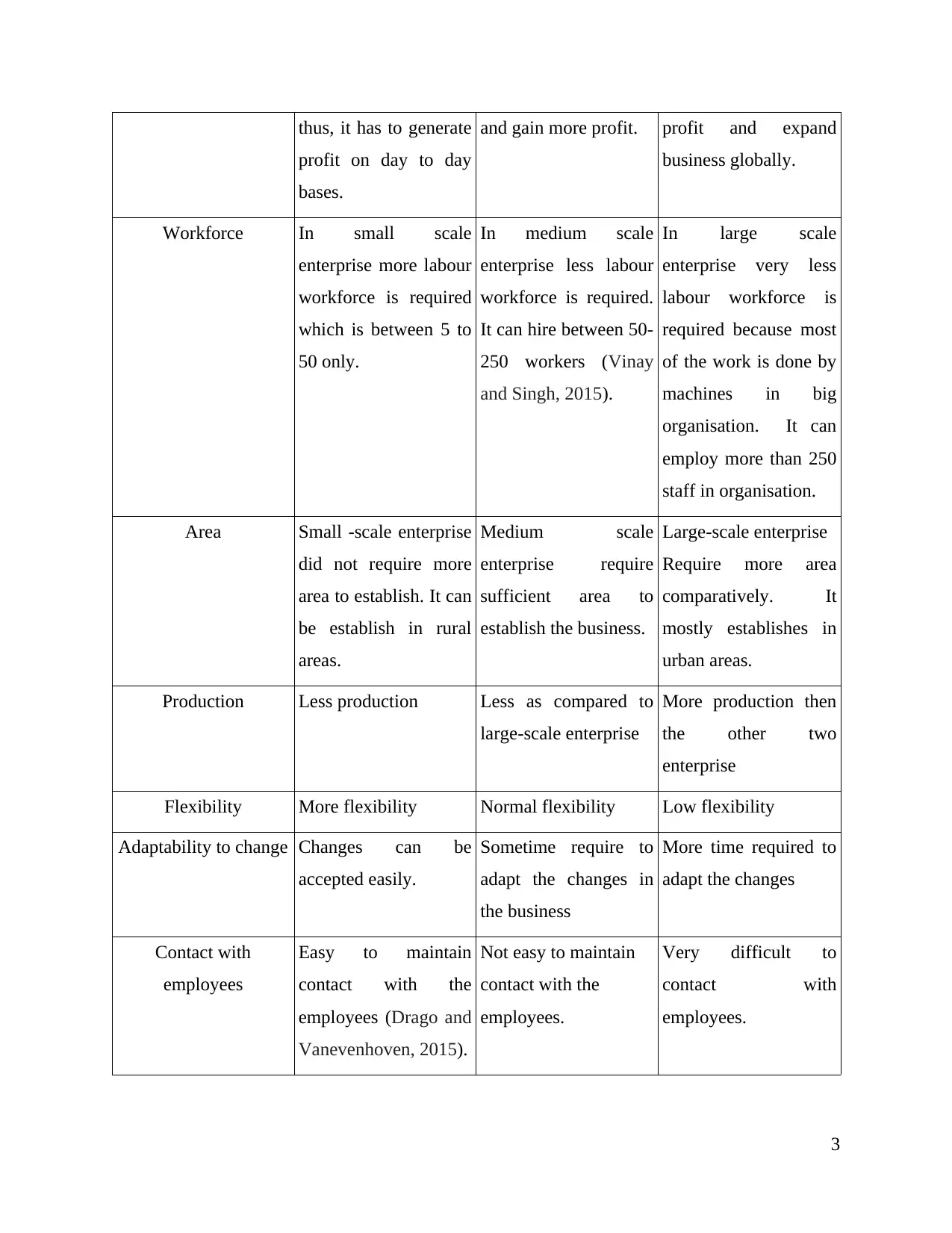
thus, it has to generate
profit on day to day
bases.
and gain more profit. profit and expand
business globally.
Workforce In small scale
enterprise more labour
workforce is required
which is between 5 to
50 only.
In medium scale
enterprise less labour
workforce is required.
It can hire between 50-
250 workers (Vinay
and Singh, 2015).
In large scale
enterprise very less
labour workforce is
required because most
of the work is done by
machines in big
organisation. It can
employ more than 250
staff in organisation.
Area Small -scale enterprise
did not require more
area to establish. It can
be establish in rural
areas.
Medium scale
enterprise require
sufficient area to
establish the business.
Large-scale enterprise
Require more area
comparatively. It
mostly establishes in
urban areas.
Production Less production Less as compared to
large-scale enterprise
More production then
the other two
enterprise
Flexibility More flexibility Normal flexibility Low flexibility
Adaptability to change Changes can be
accepted easily.
Sometime require to
adapt the changes in
the business
More time required to
adapt the changes
Contact with
employees
Easy to maintain
contact with the
employees (Drago and
Vanevenhoven, 2015).
Not easy to maintain
contact with the
employees.
Very difficult to
contact with
employees.
3
profit on day to day
bases.
and gain more profit. profit and expand
business globally.
Workforce In small scale
enterprise more labour
workforce is required
which is between 5 to
50 only.
In medium scale
enterprise less labour
workforce is required.
It can hire between 50-
250 workers (Vinay
and Singh, 2015).
In large scale
enterprise very less
labour workforce is
required because most
of the work is done by
machines in big
organisation. It can
employ more than 250
staff in organisation.
Area Small -scale enterprise
did not require more
area to establish. It can
be establish in rural
areas.
Medium scale
enterprise require
sufficient area to
establish the business.
Large-scale enterprise
Require more area
comparatively. It
mostly establishes in
urban areas.
Production Less production Less as compared to
large-scale enterprise
More production then
the other two
enterprise
Flexibility More flexibility Normal flexibility Low flexibility
Adaptability to change Changes can be
accepted easily.
Sometime require to
adapt the changes in
the business
More time required to
adapt the changes
Contact with
employees
Easy to maintain
contact with the
employees (Drago and
Vanevenhoven, 2015).
Not easy to maintain
contact with the
employees.
Very difficult to
contact with
employees.
3
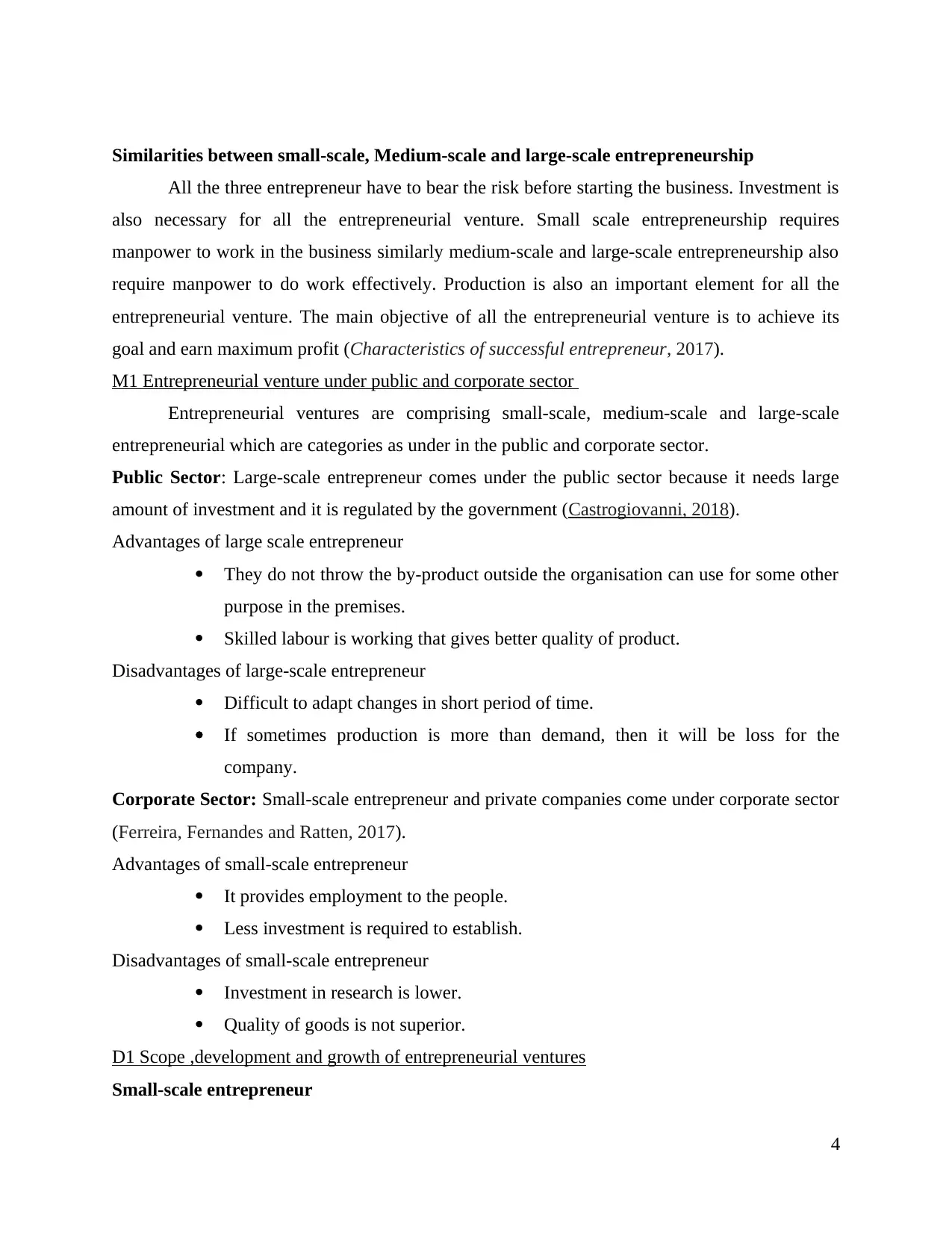
Similarities between small-scale, Medium-scale and large-scale entrepreneurship
All the three entrepreneur have to bear the risk before starting the business. Investment is
also necessary for all the entrepreneurial venture. Small scale entrepreneurship requires
manpower to work in the business similarly medium-scale and large-scale entrepreneurship also
require manpower to do work effectively. Production is also an important element for all the
entrepreneurial venture. The main objective of all the entrepreneurial venture is to achieve its
goal and earn maximum profit (Characteristics of successful entrepreneur, 2017).
M1 Entrepreneurial venture under public and corporate sector
Entrepreneurial ventures are comprising small-scale, medium-scale and large-scale
entrepreneurial which are categories as under in the public and corporate sector.
Public Sector: Large-scale entrepreneur comes under the public sector because it needs large
amount of investment and it is regulated by the government (Castrogiovanni, 2018).
Advantages of large scale entrepreneur
They do not throw the by-product outside the organisation can use for some other
purpose in the premises.
Skilled labour is working that gives better quality of product.
Disadvantages of large-scale entrepreneur
Difficult to adapt changes in short period of time.
If sometimes production is more than demand, then it will be loss for the
company.
Corporate Sector: Small-scale entrepreneur and private companies come under corporate sector
(Ferreira, Fernandes and Ratten, 2017).
Advantages of small-scale entrepreneur
It provides employment to the people.
Less investment is required to establish.
Disadvantages of small-scale entrepreneur
Investment in research is lower.
Quality of goods is not superior.
D1 Scope ,development and growth of entrepreneurial ventures
Small-scale entrepreneur
4
All the three entrepreneur have to bear the risk before starting the business. Investment is
also necessary for all the entrepreneurial venture. Small scale entrepreneurship requires
manpower to work in the business similarly medium-scale and large-scale entrepreneurship also
require manpower to do work effectively. Production is also an important element for all the
entrepreneurial venture. The main objective of all the entrepreneurial venture is to achieve its
goal and earn maximum profit (Characteristics of successful entrepreneur, 2017).
M1 Entrepreneurial venture under public and corporate sector
Entrepreneurial ventures are comprising small-scale, medium-scale and large-scale
entrepreneurial which are categories as under in the public and corporate sector.
Public Sector: Large-scale entrepreneur comes under the public sector because it needs large
amount of investment and it is regulated by the government (Castrogiovanni, 2018).
Advantages of large scale entrepreneur
They do not throw the by-product outside the organisation can use for some other
purpose in the premises.
Skilled labour is working that gives better quality of product.
Disadvantages of large-scale entrepreneur
Difficult to adapt changes in short period of time.
If sometimes production is more than demand, then it will be loss for the
company.
Corporate Sector: Small-scale entrepreneur and private companies come under corporate sector
(Ferreira, Fernandes and Ratten, 2017).
Advantages of small-scale entrepreneur
It provides employment to the people.
Less investment is required to establish.
Disadvantages of small-scale entrepreneur
Investment in research is lower.
Quality of goods is not superior.
D1 Scope ,development and growth of entrepreneurial ventures
Small-scale entrepreneur
4
⊘ This is a preview!⊘
Do you want full access?
Subscribe today to unlock all pages.

Trusted by 1+ million students worldwide
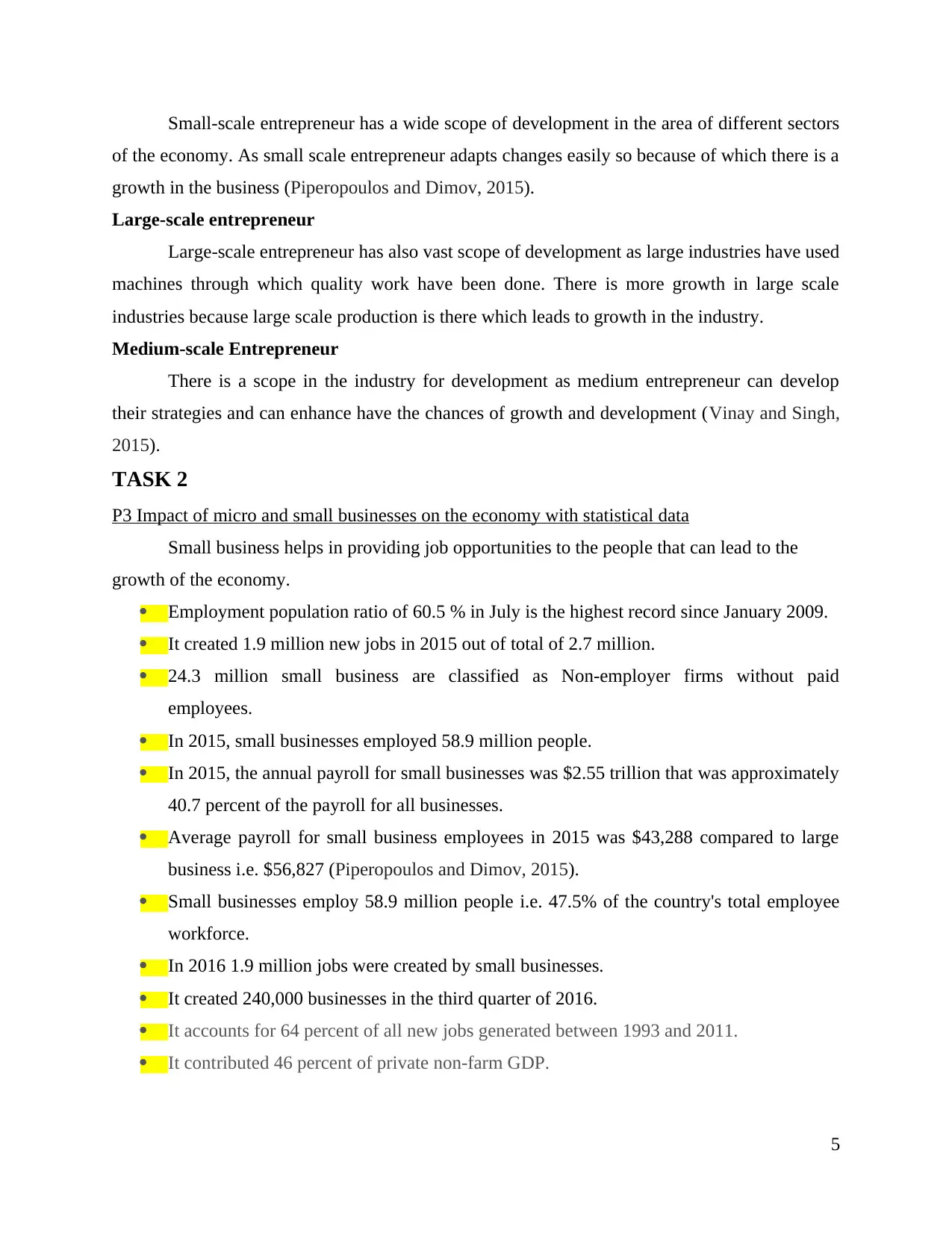
Small-scale entrepreneur has a wide scope of development in the area of different sectors
of the economy. As small scale entrepreneur adapts changes easily so because of which there is a
growth in the business (Piperopoulos and Dimov, 2015).
Large-scale entrepreneur
Large-scale entrepreneur has also vast scope of development as large industries have used
machines through which quality work have been done. There is more growth in large scale
industries because large scale production is there which leads to growth in the industry.
Medium-scale Entrepreneur
There is a scope in the industry for development as medium entrepreneur can develop
their strategies and can enhance have the chances of growth and development (Vinay and Singh,
2015).
TASK 2
P3 Impact of micro and small businesses on the economy with statistical data
Small business helps in providing job opportunities to the people that can lead to the
growth of the economy.
Employment population ratio of 60.5 % in July is the highest record since January 2009.
It created 1.9 million new jobs in 2015 out of total of 2.7 million.
24.3 million small business are classified as Non-employer firms without paid
employees.
In 2015, small businesses employed 58.9 million people.
In 2015, the annual payroll for small businesses was $2.55 trillion that was approximately
40.7 percent of the payroll for all businesses.
Average payroll for small business employees in 2015 was $43,288 compared to large
business i.e. $56,827 (Piperopoulos and Dimov, 2015).
Small businesses employ 58.9 million people i.e. 47.5% of the country's total employee
workforce.
In 2016 1.9 million jobs were created by small businesses.
It created 240,000 businesses in the third quarter of 2016.
It accounts for 64 percent of all new jobs generated between 1993 and 2011.
It contributed 46 percent of private non-farm GDP.
5
of the economy. As small scale entrepreneur adapts changes easily so because of which there is a
growth in the business (Piperopoulos and Dimov, 2015).
Large-scale entrepreneur
Large-scale entrepreneur has also vast scope of development as large industries have used
machines through which quality work have been done. There is more growth in large scale
industries because large scale production is there which leads to growth in the industry.
Medium-scale Entrepreneur
There is a scope in the industry for development as medium entrepreneur can develop
their strategies and can enhance have the chances of growth and development (Vinay and Singh,
2015).
TASK 2
P3 Impact of micro and small businesses on the economy with statistical data
Small business helps in providing job opportunities to the people that can lead to the
growth of the economy.
Employment population ratio of 60.5 % in July is the highest record since January 2009.
It created 1.9 million new jobs in 2015 out of total of 2.7 million.
24.3 million small business are classified as Non-employer firms without paid
employees.
In 2015, small businesses employed 58.9 million people.
In 2015, the annual payroll for small businesses was $2.55 trillion that was approximately
40.7 percent of the payroll for all businesses.
Average payroll for small business employees in 2015 was $43,288 compared to large
business i.e. $56,827 (Piperopoulos and Dimov, 2015).
Small businesses employ 58.9 million people i.e. 47.5% of the country's total employee
workforce.
In 2016 1.9 million jobs were created by small businesses.
It created 240,000 businesses in the third quarter of 2016.
It accounts for 64 percent of all new jobs generated between 1993 and 2011.
It contributed 46 percent of private non-farm GDP.
5
Paraphrase This Document
Need a fresh take? Get an instant paraphrase of this document with our AI Paraphraser
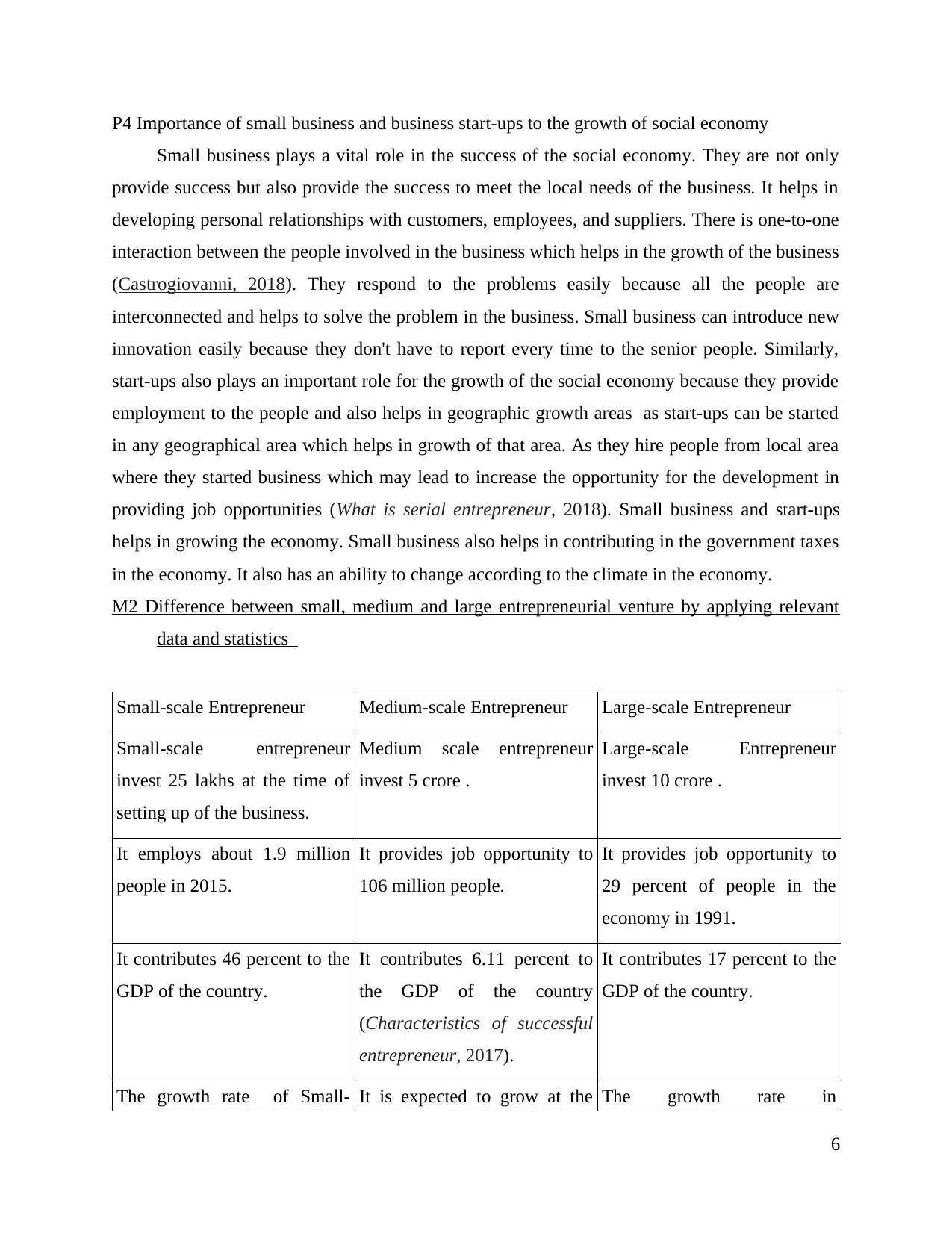
P4 Importance of small business and business start-ups to the growth of social economy
Small business plays a vital role in the success of the social economy. They are not only
provide success but also provide the success to meet the local needs of the business. It helps in
developing personal relationships with customers, employees, and suppliers. There is one-to-one
interaction between the people involved in the business which helps in the growth of the business
(Castrogiovanni, 2018). They respond to the problems easily because all the people are
interconnected and helps to solve the problem in the business. Small business can introduce new
innovation easily because they don't have to report every time to the senior people. Similarly,
start-ups also plays an important role for the growth of the social economy because they provide
employment to the people and also helps in geographic growth areas as start-ups can be started
in any geographical area which helps in growth of that area. As they hire people from local area
where they started business which may lead to increase the opportunity for the development in
providing job opportunities (What is serial entrepreneur, 2018). Small business and start-ups
helps in growing the economy. Small business also helps in contributing in the government taxes
in the economy. It also has an ability to change according to the climate in the economy.
M2 Difference between small, medium and large entrepreneurial venture by applying relevant
data and statistics
Small-scale Entrepreneur Medium-scale Entrepreneur Large-scale Entrepreneur
Small-scale entrepreneur
invest 25 lakhs at the time of
setting up of the business.
Medium scale entrepreneur
invest 5 crore .
Large-scale Entrepreneur
invest 10 crore .
It employs about 1.9 million
people in 2015.
It provides job opportunity to
106 million people.
It provides job opportunity to
29 percent of people in the
economy in 1991.
It contributes 46 percent to the
GDP of the country.
It contributes 6.11 percent to
the GDP of the country
(Characteristics of successful
entrepreneur, 2017).
It contributes 17 percent to the
GDP of the country.
The growth rate of Small- It is expected to grow at the The growth rate in
6
Small business plays a vital role in the success of the social economy. They are not only
provide success but also provide the success to meet the local needs of the business. It helps in
developing personal relationships with customers, employees, and suppliers. There is one-to-one
interaction between the people involved in the business which helps in the growth of the business
(Castrogiovanni, 2018). They respond to the problems easily because all the people are
interconnected and helps to solve the problem in the business. Small business can introduce new
innovation easily because they don't have to report every time to the senior people. Similarly,
start-ups also plays an important role for the growth of the social economy because they provide
employment to the people and also helps in geographic growth areas as start-ups can be started
in any geographical area which helps in growth of that area. As they hire people from local area
where they started business which may lead to increase the opportunity for the development in
providing job opportunities (What is serial entrepreneur, 2018). Small business and start-ups
helps in growing the economy. Small business also helps in contributing in the government taxes
in the economy. It also has an ability to change according to the climate in the economy.
M2 Difference between small, medium and large entrepreneurial venture by applying relevant
data and statistics
Small-scale Entrepreneur Medium-scale Entrepreneur Large-scale Entrepreneur
Small-scale entrepreneur
invest 25 lakhs at the time of
setting up of the business.
Medium scale entrepreneur
invest 5 crore .
Large-scale Entrepreneur
invest 10 crore .
It employs about 1.9 million
people in 2015.
It provides job opportunity to
106 million people.
It provides job opportunity to
29 percent of people in the
economy in 1991.
It contributes 46 percent to the
GDP of the country.
It contributes 6.11 percent to
the GDP of the country
(Characteristics of successful
entrepreneur, 2017).
It contributes 17 percent to the
GDP of the country.
The growth rate of Small- It is expected to grow at the The growth rate in
6
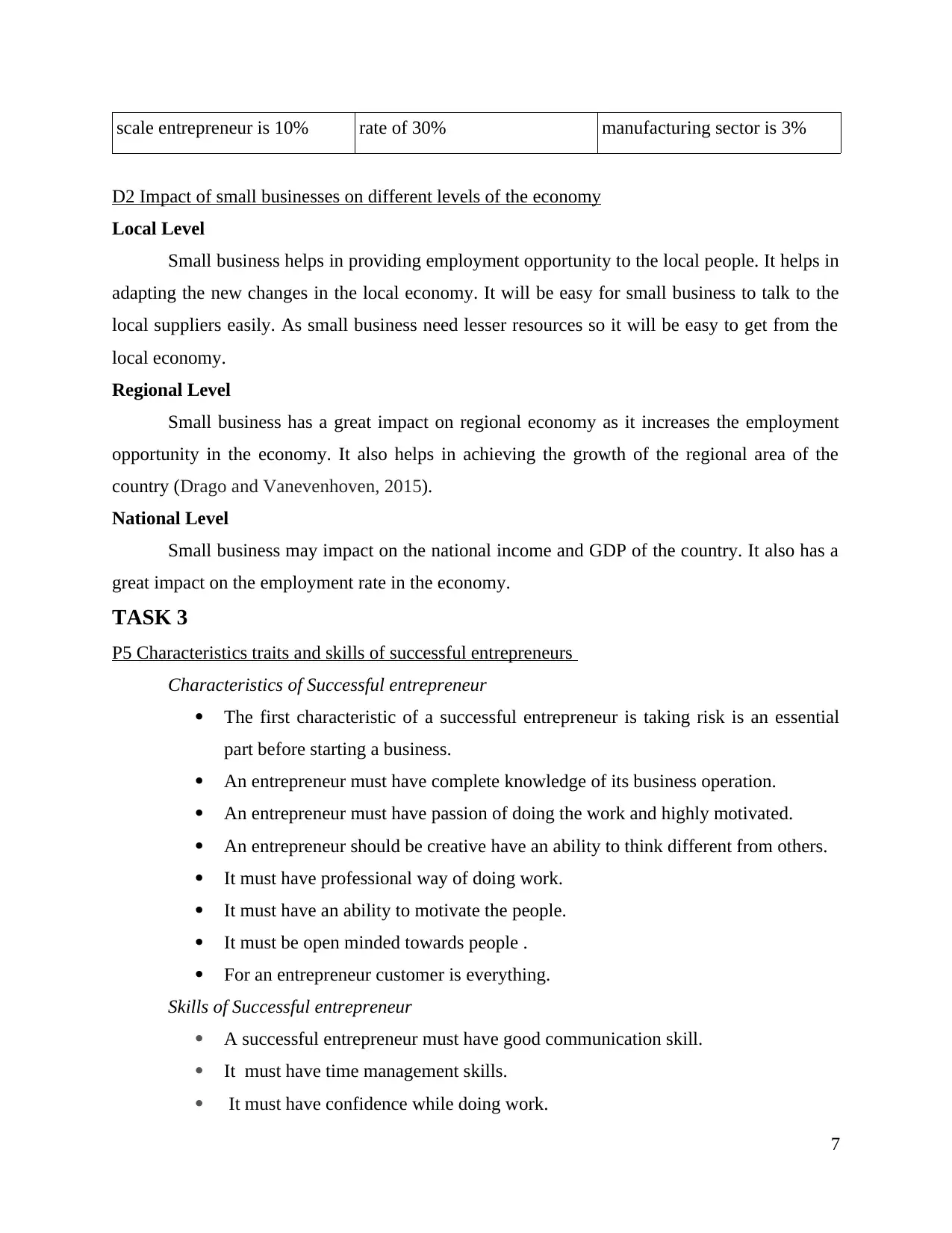
scale entrepreneur is 10% rate of 30% manufacturing sector is 3%
D2 Impact of small businesses on different levels of the economy
Local Level
Small business helps in providing employment opportunity to the local people. It helps in
adapting the new changes in the local economy. It will be easy for small business to talk to the
local suppliers easily. As small business need lesser resources so it will be easy to get from the
local economy.
Regional Level
Small business has a great impact on regional economy as it increases the employment
opportunity in the economy. It also helps in achieving the growth of the regional area of the
country (Drago and Vanevenhoven, 2015).
National Level
Small business may impact on the national income and GDP of the country. It also has a
great impact on the employment rate in the economy.
TASK 3
P5 Characteristics traits and skills of successful entrepreneurs
Characteristics of Successful entrepreneur
The first characteristic of a successful entrepreneur is taking risk is an essential
part before starting a business.
An entrepreneur must have complete knowledge of its business operation.
An entrepreneur must have passion of doing the work and highly motivated.
An entrepreneur should be creative have an ability to think different from others.
It must have professional way of doing work.
It must have an ability to motivate the people.
It must be open minded towards people .
For an entrepreneur customer is everything.
Skills of Successful entrepreneur
A successful entrepreneur must have good communication skill.
It must have time management skills.
It must have confidence while doing work.
7
D2 Impact of small businesses on different levels of the economy
Local Level
Small business helps in providing employment opportunity to the local people. It helps in
adapting the new changes in the local economy. It will be easy for small business to talk to the
local suppliers easily. As small business need lesser resources so it will be easy to get from the
local economy.
Regional Level
Small business has a great impact on regional economy as it increases the employment
opportunity in the economy. It also helps in achieving the growth of the regional area of the
country (Drago and Vanevenhoven, 2015).
National Level
Small business may impact on the national income and GDP of the country. It also has a
great impact on the employment rate in the economy.
TASK 3
P5 Characteristics traits and skills of successful entrepreneurs
Characteristics of Successful entrepreneur
The first characteristic of a successful entrepreneur is taking risk is an essential
part before starting a business.
An entrepreneur must have complete knowledge of its business operation.
An entrepreneur must have passion of doing the work and highly motivated.
An entrepreneur should be creative have an ability to think different from others.
It must have professional way of doing work.
It must have an ability to motivate the people.
It must be open minded towards people .
For an entrepreneur customer is everything.
Skills of Successful entrepreneur
A successful entrepreneur must have good communication skill.
It must have time management skills.
It must have confidence while doing work.
7
⊘ This is a preview!⊘
Do you want full access?
Subscribe today to unlock all pages.

Trusted by 1+ million students worldwide

It must have ability to relieve stress.
It must have ability to do productive work.
P6 Aspects of the entrepreneurial personality reflect motivation and mind-set
Personality reflects the person’s characteristics and qualities that a person is having in it.
It can be changed by influencing from external and internal factors. It helps in bringing positive
attitude in an individual. For example: Lisa Nichols was motivational speaker and she has
struggled in her life to meet the ends. She is also considered as the bestselling author. Through
its struggle many people are motivated through it . (Eggers and Song, 2015). Another one is Tom
Mercer selling food in his country also pursue the positive attitude towards business and get
successful in his work. Setting a positive mind-set helps in achieving goals of the business.
D3 Characteristics traits and skills and motivational drivers of successful entrepreneur
An entrepreneur possess many characteristics traits and skills as an entrepreneur should
be risk taking before start a business. It should have open minded towards the people in the
business. It should have an ability to understand another person emotions. A good entrepreneur
must know that its customer is everything and know the needs and wants of the customers.
TASK 4
P7 Background and experience hinder or foster entrepreneurship.
Background and experience can reflect the future of an entrepreneur, As Lisa Nichols
was 27 year old lady is a single mom who has done struggle to meet the end. She has $12in her
account but she told her son that she is never broken before as she is today this is the turning
point in her life. She is a best selling author and has caught attention of many media outlets.Her
aim is to help others and achieve success by using its own experience. On other hand Tom
Mercer is another successful entrepreneur, since his childhood he wanted to open his own
business thus, he always thinks about business ideas (Characteristics of successful entrepreneur,
2017). He belongs from educated family thus, family background has helped me to work hard
and take risks.
If the person has strong financial background, then it helps individual in getting funds for
new business start up whereas if the person has good experience then individual can utilise its
experience well and can work hard to become a successful business owner.
8
It must have ability to do productive work.
P6 Aspects of the entrepreneurial personality reflect motivation and mind-set
Personality reflects the person’s characteristics and qualities that a person is having in it.
It can be changed by influencing from external and internal factors. It helps in bringing positive
attitude in an individual. For example: Lisa Nichols was motivational speaker and she has
struggled in her life to meet the ends. She is also considered as the bestselling author. Through
its struggle many people are motivated through it . (Eggers and Song, 2015). Another one is Tom
Mercer selling food in his country also pursue the positive attitude towards business and get
successful in his work. Setting a positive mind-set helps in achieving goals of the business.
D3 Characteristics traits and skills and motivational drivers of successful entrepreneur
An entrepreneur possess many characteristics traits and skills as an entrepreneur should
be risk taking before start a business. It should have open minded towards the people in the
business. It should have an ability to understand another person emotions. A good entrepreneur
must know that its customer is everything and know the needs and wants of the customers.
TASK 4
P7 Background and experience hinder or foster entrepreneurship.
Background and experience can reflect the future of an entrepreneur, As Lisa Nichols
was 27 year old lady is a single mom who has done struggle to meet the end. She has $12in her
account but she told her son that she is never broken before as she is today this is the turning
point in her life. She is a best selling author and has caught attention of many media outlets.Her
aim is to help others and achieve success by using its own experience. On other hand Tom
Mercer is another successful entrepreneur, since his childhood he wanted to open his own
business thus, he always thinks about business ideas (Characteristics of successful entrepreneur,
2017). He belongs from educated family thus, family background has helped me to work hard
and take risks.
If the person has strong financial background, then it helps individual in getting funds for
new business start up whereas if the person has good experience then individual can utilise its
experience well and can work hard to become a successful business owner.
8
Paraphrase This Document
Need a fresh take? Get an instant paraphrase of this document with our AI Paraphraser
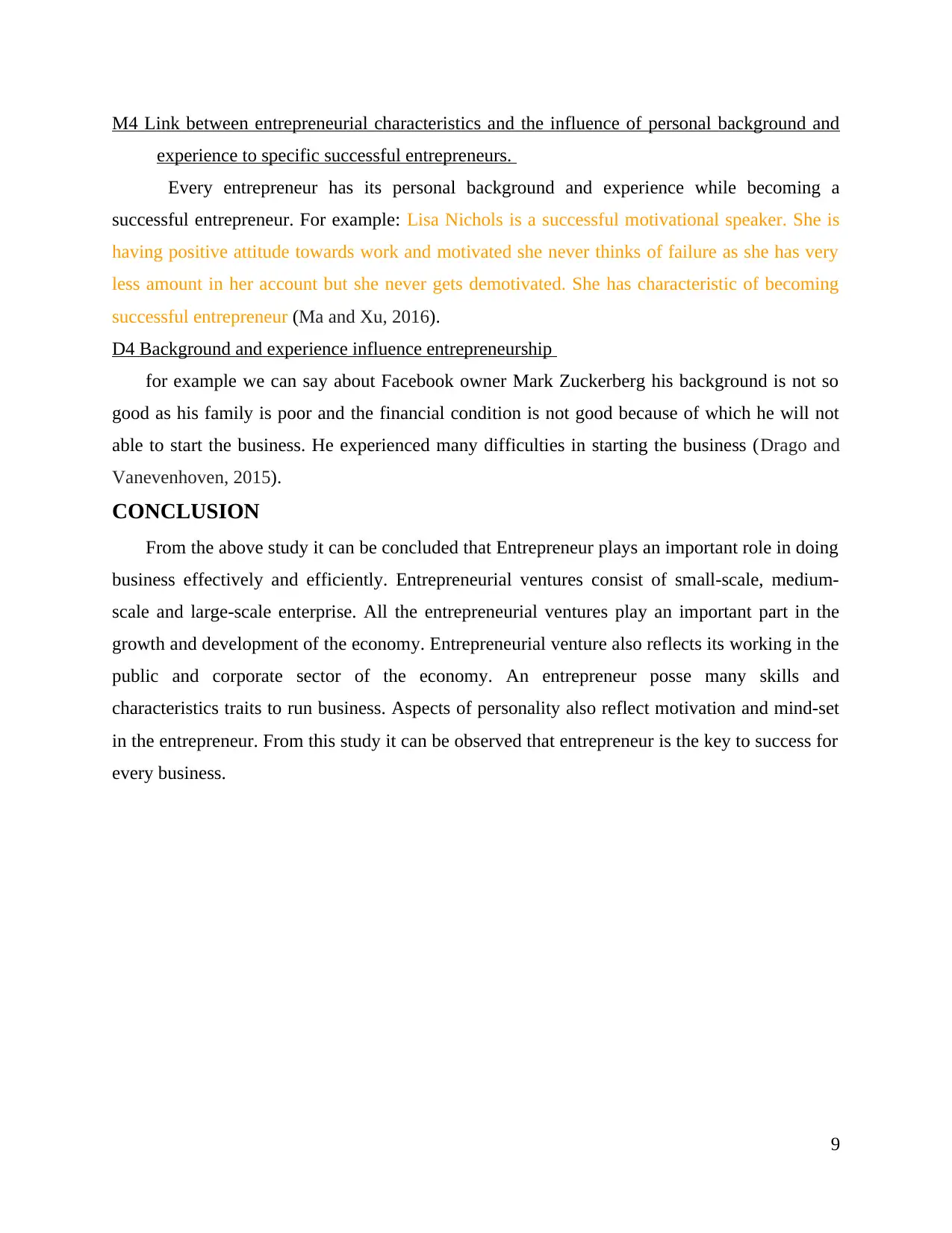
M4 Link between entrepreneurial characteristics and the influence of personal background and
experience to specific successful entrepreneurs.
Every entrepreneur has its personal background and experience while becoming a
successful entrepreneur. For example: Lisa Nichols is a successful motivational speaker. She is
having positive attitude towards work and motivated she never thinks of failure as she has very
less amount in her account but she never gets demotivated. She has characteristic of becoming
successful entrepreneur (Ma and Xu, 2016).
D4 Background and experience influence entrepreneurship
for example we can say about Facebook owner Mark Zuckerberg his background is not so
good as his family is poor and the financial condition is not good because of which he will not
able to start the business. He experienced many difficulties in starting the business (Drago and
Vanevenhoven, 2015).
CONCLUSION
From the above study it can be concluded that Entrepreneur plays an important role in doing
business effectively and efficiently. Entrepreneurial ventures consist of small-scale, medium-
scale and large-scale enterprise. All the entrepreneurial ventures play an important part in the
growth and development of the economy. Entrepreneurial venture also reflects its working in the
public and corporate sector of the economy. An entrepreneur posse many skills and
characteristics traits to run business. Aspects of personality also reflect motivation and mind-set
in the entrepreneur. From this study it can be observed that entrepreneur is the key to success for
every business.
9
experience to specific successful entrepreneurs.
Every entrepreneur has its personal background and experience while becoming a
successful entrepreneur. For example: Lisa Nichols is a successful motivational speaker. She is
having positive attitude towards work and motivated she never thinks of failure as she has very
less amount in her account but she never gets demotivated. She has characteristic of becoming
successful entrepreneur (Ma and Xu, 2016).
D4 Background and experience influence entrepreneurship
for example we can say about Facebook owner Mark Zuckerberg his background is not so
good as his family is poor and the financial condition is not good because of which he will not
able to start the business. He experienced many difficulties in starting the business (Drago and
Vanevenhoven, 2015).
CONCLUSION
From the above study it can be concluded that Entrepreneur plays an important role in doing
business effectively and efficiently. Entrepreneurial ventures consist of small-scale, medium-
scale and large-scale enterprise. All the entrepreneurial ventures play an important part in the
growth and development of the economy. Entrepreneurial venture also reflects its working in the
public and corporate sector of the economy. An entrepreneur posse many skills and
characteristics traits to run business. Aspects of personality also reflect motivation and mind-set
in the entrepreneur. From this study it can be observed that entrepreneur is the key to success for
every business.
9

REFERENCES
Books and Journals
Castrogiovanni, G.J., 2018. Guest editor’s introduction: so what is entrepreneurship
research?. International Entrepreneurship and Management Journal.14(3).pp.509-511.
Drago, W.A. and Vanevenhoven, J., 2015. The structure and scope of entrepreneurship programs
in higher education around the world. In Entrepreneurial Learning (pp. 117-133).
Routledge.
Eggers, J.P. and Song, L., 2015. Dealing with failure: Serial entrepreneurs and the costs of
changing industries between ventures. Academy of Management Journal. 58(6). pp.1785-
1803.
Ferreira, J.J., Fernandes, C.I. and Ratten, V., 2017. Entrepreneurship, innovation and
competitiveness: what is the connection?. International Journal of Business and
Globalisation.18(1).pp.73-95.
Ma, S. and Xu, H., 2016. From consumption to production: understanding the tourism lifestyle
entrepreneur in Dali. Tourism Tribune. 31(5).pp.81-88.
Masurel, E. and Snellenberg, R., 2017. Does the lifestyle entrepreneur exist? An analysis of
lifestyle entrepreneurs compared with other entrepreneurs on the basis of the
development of entrepreneurial competences. Research Memorandum. 1. pp.1-14.
Piperopoulos, P. and Dimov, D., 2015. Burst bubbles or build steam? Entrepreneurship
education, entrepreneurial self‐efficacy, and entrepreneurial intentions. Journal of Small
Business Management.53(4). pp.970-985.
Rae, D. and Wang, C.L., 2015. Entrepreneurial learning: past research and future challenges.
In Entrepreneurial learning(pp. 25-58). Routledge.
Vinay, D. and Singh, D., 2015. Status and scope of women entrepreneurship. Universal Journal
of Management.3(2).pp.43-51.
Online
Characteristics of successful entrepreneur.2017.[Online].Available
through<https://www.jbcnschool.edu.in/blog/characteristics-of-an-entrepreneur/>
What is an SME. 2012. [Online]. Available through <
https://www.thecompanywarehouse.co.uk/blog/what-is-an-sme>
10
Books and Journals
Castrogiovanni, G.J., 2018. Guest editor’s introduction: so what is entrepreneurship
research?. International Entrepreneurship and Management Journal.14(3).pp.509-511.
Drago, W.A. and Vanevenhoven, J., 2015. The structure and scope of entrepreneurship programs
in higher education around the world. In Entrepreneurial Learning (pp. 117-133).
Routledge.
Eggers, J.P. and Song, L., 2015. Dealing with failure: Serial entrepreneurs and the costs of
changing industries between ventures. Academy of Management Journal. 58(6). pp.1785-
1803.
Ferreira, J.J., Fernandes, C.I. and Ratten, V., 2017. Entrepreneurship, innovation and
competitiveness: what is the connection?. International Journal of Business and
Globalisation.18(1).pp.73-95.
Ma, S. and Xu, H., 2016. From consumption to production: understanding the tourism lifestyle
entrepreneur in Dali. Tourism Tribune. 31(5).pp.81-88.
Masurel, E. and Snellenberg, R., 2017. Does the lifestyle entrepreneur exist? An analysis of
lifestyle entrepreneurs compared with other entrepreneurs on the basis of the
development of entrepreneurial competences. Research Memorandum. 1. pp.1-14.
Piperopoulos, P. and Dimov, D., 2015. Burst bubbles or build steam? Entrepreneurship
education, entrepreneurial self‐efficacy, and entrepreneurial intentions. Journal of Small
Business Management.53(4). pp.970-985.
Rae, D. and Wang, C.L., 2015. Entrepreneurial learning: past research and future challenges.
In Entrepreneurial learning(pp. 25-58). Routledge.
Vinay, D. and Singh, D., 2015. Status and scope of women entrepreneurship. Universal Journal
of Management.3(2).pp.43-51.
Online
Characteristics of successful entrepreneur.2017.[Online].Available
through<https://www.jbcnschool.edu.in/blog/characteristics-of-an-entrepreneur/>
What is an SME. 2012. [Online]. Available through <
https://www.thecompanywarehouse.co.uk/blog/what-is-an-sme>
10
⊘ This is a preview!⊘
Do you want full access?
Subscribe today to unlock all pages.

Trusted by 1+ million students worldwide
1 out of 13
Related Documents
Your All-in-One AI-Powered Toolkit for Academic Success.
+13062052269
info@desklib.com
Available 24*7 on WhatsApp / Email
![[object Object]](/_next/static/media/star-bottom.7253800d.svg)
Unlock your academic potential
Copyright © 2020–2025 A2Z Services. All Rights Reserved. Developed and managed by ZUCOL.





